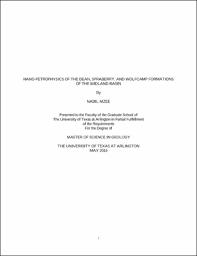
ATTENTION: The works hosted here are being migrated to a new repository that will consolidate resources, improve discoverability, and better show UTA's research impact on the global community. We will update authors as the migration progresses. Please see MavMatrix for more information.
Show simple item record
| dc.contributor.advisor | Hu, Qinhong | |
| dc.creator | Mzee, Nabil | |
| dc.date.accessioned | 2021-06-03T20:13:31Z | |
| dc.date.available | 2021-06-03T20:13:31Z | |
| dc.date.created | 2019-05 | |
| dc.date.issued | 2019-05-15 | |
| dc.date.submitted | May 2019 | |
| dc.identifier.uri | http://hdl.handle.net/10106/29891 | |
| dc.description.abstract | Technological advances in hydraulic fracturing and horizontal drilling have led to a surge in oil and gas production in unconventional shale reservoirs over the past several decades. The Permian Basin of Northwest Texas and Southeast New Mexico is no exception to this. Since 2009, when the application of these technologies went into full scale, the production in the Permian Basin has more than doubled. Despite the enormous advances in production in the Permian Basin, operators are plagued by rapid decline rates in producing wells. The root cause of the rapid production decline rates is not well understood but there is consensus that the predominance of nanopores in these unconventional reservoirs plays a significant role in the sharp production declines. In order to develop a better understanding of the production behavior in unconventional reservoirs, the nano-petrophysical properties of these reservoirs must be investigated.
This study investigates the nano-petrophysics of the Wolfcamp B, Wolfcamp A, Dean, and Spraberry Formations of the Midland sub-basin in the Permian Basin by Mercury Injection Capillary Pressure (MICP) analysis, spontaneous fluid imbibition tests, vacuum saturation and liquid displacement tests, x-ray diffraction (XRD), and pyrolysis. Most samples exhibit significant pore size distribution in pore throat diameter ranges associated with intra-clay grain space, organic matter hosted pores, and intragranular pores. Thermal maturation is found to play a significant role in the generation of pores within these pore throat ranges. The hydrophobic pore networks of the samples exhibit a better connectivity than the hydrophilic pore networks of the samples. Lastly, pore size distribution is found to be a significant controlling factor on permeability as the significant presence of pores within the 2.8-50 nm range correlates with lower permeabilities and higher tortuosities in the sample set. | |
| dc.format.mimetype | application/pdf | |
| dc.language.iso | en_US | |
| dc.subject | Wolfcamp | |
| dc.subject | Spraberry | |
| dc.subject | Dean | |
| dc.subject | petrophysics | |
| dc.subject | Nano-petrophysics | |
| dc.subject | Nabil Mzee | |
| dc.subject | Mzee | |
| dc.subject | Wolfcamp A | |
| dc.subject | Wolfcamp B | |
| dc.subject | Permian basin | |
| dc.title | NANO-PETROPHYSICS OF THE DEAN, SPRABERRY, AND WOLFCAMP FORMATIONS OF THE MIDLAND BASIN | |
| dc.type | Thesis | |
| dc.degree.department | Earth and Environmental Sciences | |
| dc.degree.name | Master of Science in Earth and Environmental Science | |
| dc.date.updated | 2021-06-03T20:13:35Z | |
| thesis.degree.department | Earth and Environmental Sciences | |
| thesis.degree.grantor | The University of Texas at Arlington | |
| thesis.degree.level | Masters | |
| thesis.degree.name | Master of Science in Earth and Environmental Science | |
| dc.type.material | text | |
| dc.creator.orcid | 0000-0002-4269-7104 | |
Files in this item
- Name:
- MZEE-THESIS-2019.pdf
- Size:
- 3.808Mb
- Format:
- PDF
This item appears in the following Collection(s)
Show simple item record


